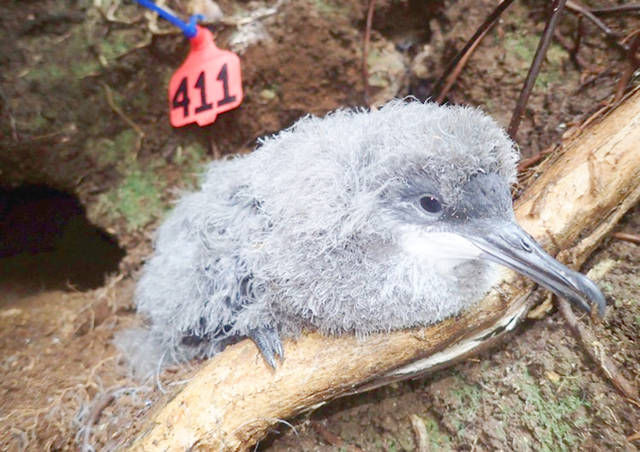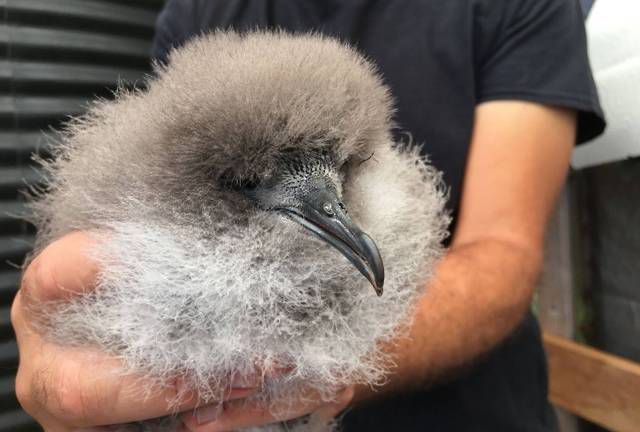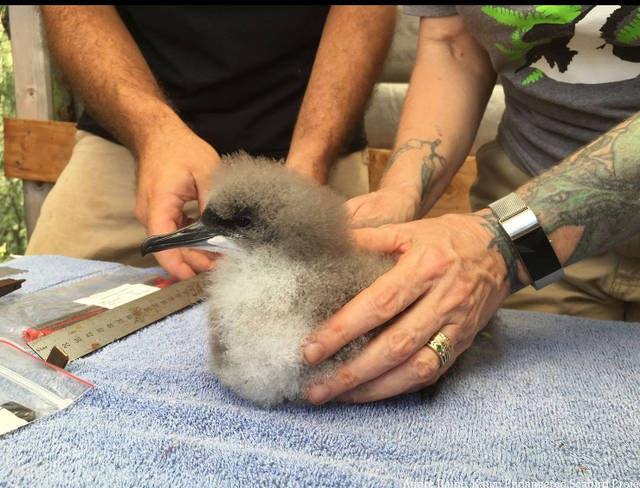KILAUEA — Another group of Newell’s shearwater chicks took their first flight in mid-September, safely tucked in cardboard carriers aboard a much bigger bird.
It’s part of an ongoing conservation strategy for the Newell’s shearwater and Hawaiian petrel birds, both of which are flagship seabird species for Kauai and have suffered huge population declines in recent years, said Andre Raine, with Kauai Endangered Seabird Recovery Project.
“This project is an important facet of the conservation of the Newell’s shearwater and Hawaiian petrel,” he said.
On Sept. 13 and Sept. 14, some 18 chicks were flown via helicopter from multiple sites in Hono o Na Pali Natural Area Reserve, Upper Limhauli and Kilauea Point National Wildlife Refuge.
Their destination: Man-made burrows in the Nihoku predator-proof sanctuary inside KPNWR.
Before the two-day translocation, project members at Nihoku prepared the site for the incoming chicks. It’s the second year of Newell’s shearwater translocations.
“We cleared and treated just over an acre, weeded and treated the existing restoration sites and out-planted 7,000 native plants,” said Jennifer Waipa, KPNWR supervisory park ranger.
Additional preparations are in the works for the upcoming Hawaiian petrel translocation, according to Waipa. That part of the project’s timeframe has yet to be announced and will be the third translocation of Hawaiian petrels to Nihoku.
The project is under the wings of KESRP, Pacific Rim Conservation, American Bird Conservancy, National Fish and Wildlife Foundation, U.S. Fish and Wildlife Service, state Department of Land and Natural Resources, Pacific Studies Co-operative Unit and National Tropical Botanical Garden.
“It’s a multi-partner project with many moving parts, and has been successful so far due to the hard work of all of the various partners,” Raine said.
The project started in 2015 with 10 Hawaiian petrels successfully translocated from their mountain breeding colonies to the new, protected Nihoku colony. In 2016, the first eight Newell’s shearwater residents were brought to the colony.
Both seabird species imprint on their birth colonies the first time they leave their burrows and see the night sky. Because they were relocated to the Nihoku colony they will imprint on that location after emerging from the man-made burrows. They will return to Nihoku as adults, after three or four solid years out to sea.
Translocating chicks is always challenging, according to Raine, and the project starts long before the little fuzzy bundles are removed from their burrows.
“We monitor them throughout the season from the time of the adults’ arrival until the time we translocate them, visiting the colonies once a month to check on them,” Raine said.
Ongoing protection of the colonies by controlling invasive predators like cats, rats and pigs is also an important element to the project.
During the actual translocation, KESRP teams went to the burrows designated for the project and removed the birds.
The chicks were then placed into special carrying boxes, and hiked through the forest to helicopter landing areas where they were then flown to Princeville airport and handed over to biologists from Pacific Rim Conservation, who will care for them until fledging.
And this year, the extractions from Hono o Na Pali were complicated on the first day by a heavy layer of fog.
“The team was stuck for half an hour with the chicks waiting for the weather to improve,” Raine said. “Luckily the weather improved and that, coupled with the skillful flying of our pilot Chris from Airborne Aviation, we managed to get the team and the birds out safely.”
Now that the chicks are tucked into their protected burrows at Nihoku, they’ll be fed a slurry of fish and squid, and their growth will be monitored until they fledge.
It is part of a comprehensive conservation strategy for the two species.
“On Kauai, (that) also includes managing seabird colonies in the mountains through the control of introduced predators and plants, and reduction of powerline collisions and light-attraction threats,” Raine said.






